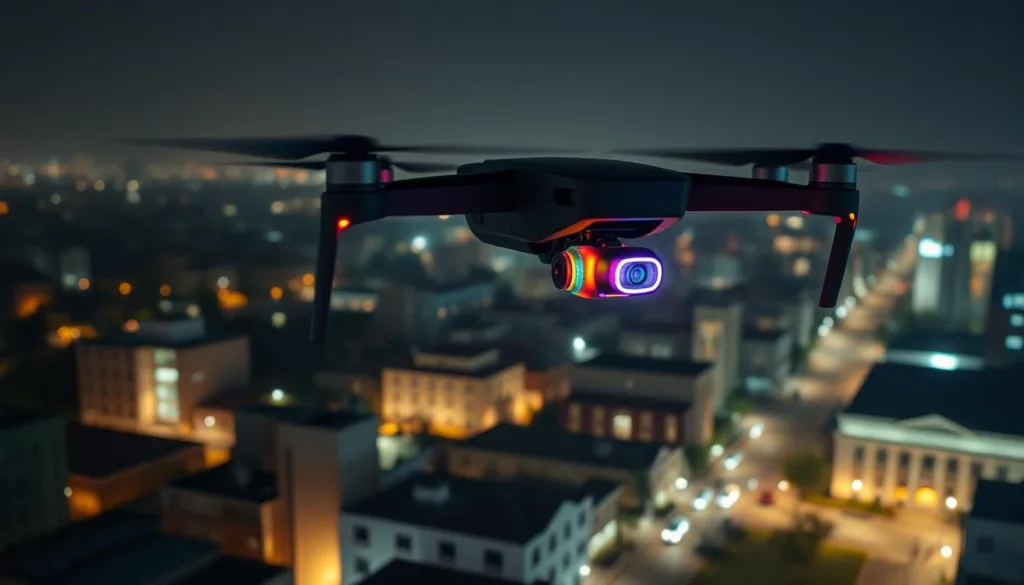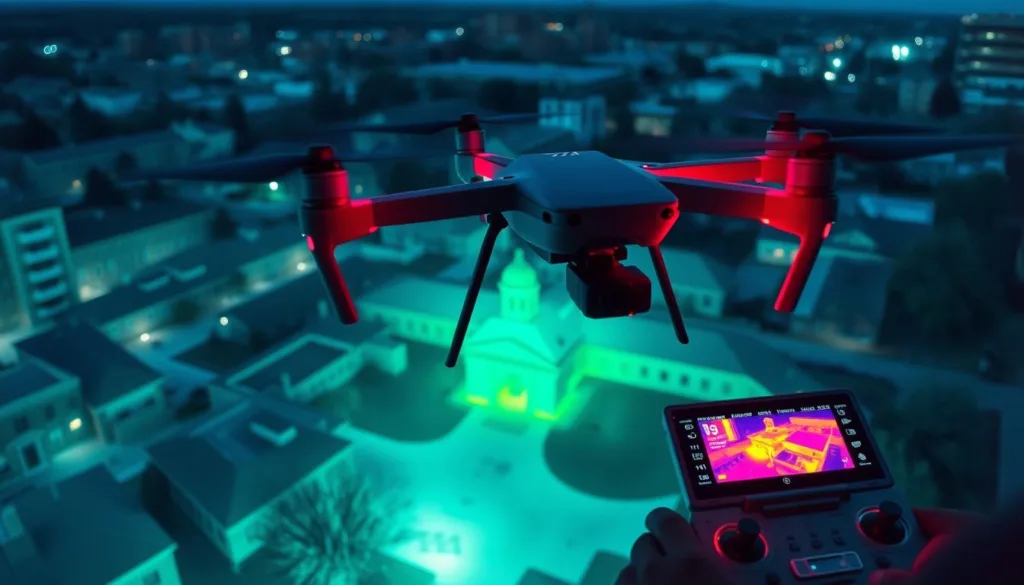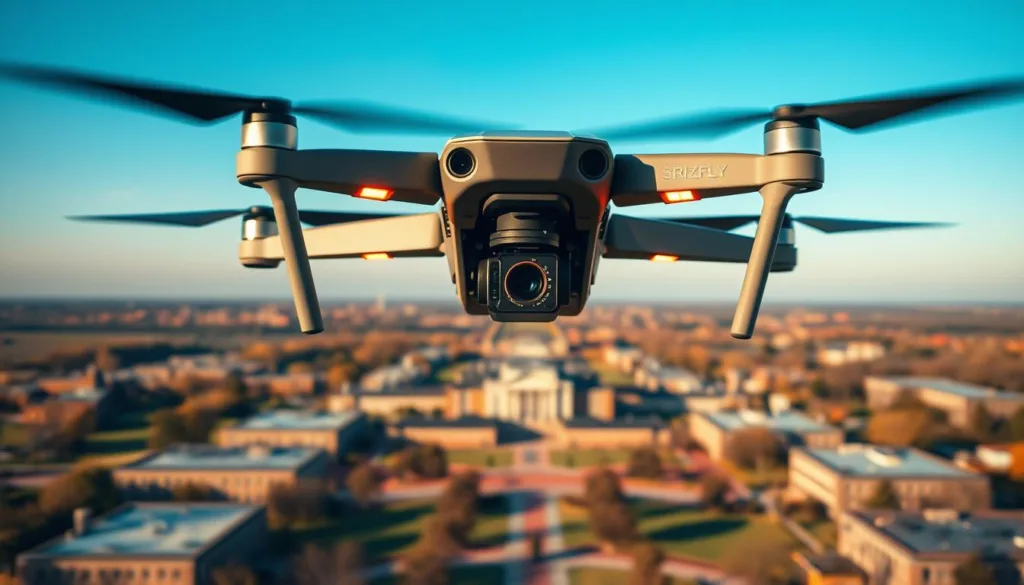Campus security is a multifaceted challenge that requires innovative solutions. The TOM-S1 Safe Campus Solution combines a drone field with a low-altitude grid-based intelligent patrol platform to achieve all-weather automatic patrols and early warnings, enhancing teaching, learning, research, and student safety.
By leveraging AI-driven drone thermal inspection, campuses can automate patrols, strengthen emergency response, and protect their communities more effectively. This cutting-edge approach supplements traditional security measures with AI intelligent algorithms, providing a cost-effective solution for improving campus security.
Key Takeaways
- Enhanced campus security through automated patrols
- Early warnings and emergency response
- Cost-effective solution for campus safety
- Integration of AI intelligent algorithms
- All-weather automatic patrol capabilities
Understanding Drone Thermal Inspection Technology
Understanding the technology behind drone thermal inspection is crucial for its effective implementation on campuses. Drone thermal inspection technology involves using drones equipped with thermal cameras to detect temperature differences in a given area.

What is Drone Thermal Inspection?
Drone thermal inspection, also known as drone infrared inspection, utilizes thermal imaging cameras mounted on drones to capture temperature variations. This technology is particularly useful for detecting anomalies such as energy leaks, water damage, or intruders on campus.
How Does It Work?
The process involves flying a thermal imaging drone over the campus area to capture thermal images. These images are then analyzed using AI algorithms to identify any temperature anomalies. The use of AI-powered analytics enhances the detection of potential security threats, making campus security more proactive.
- Capturing thermal images using drones
- Analyzing images with AI algorithms
- Identifying temperature anomalies
Benefits of Using Thermal Imaging
The benefits of using thermal drone survey technology are multifaceted. It enhances security by detecting intruders or potential threats early. It also offers cost savings by identifying issues such as energy leaks or water damage before they become major problems. Furthermore, it improves safety for both the campus community and security personnel by reducing the need for manual inspections in potentially hazardous areas.
- Enhanced security through early detection
- Cost savings through preventive maintenance
- Improved safety for personnel and the campus community
By leveraging drone infrared inspection technology, campuses can significantly strengthen their security measures. The integration of AI intelligent algorithms with thermal imaging drones represents a significant advancement in campus security protection.
The TOM-S1 Safe Campus Solution Explained
The TOM-S1 Safe Campus Solution combines drone technology with AI-driven thermal imaging for comprehensive campus security. This innovative approach ensures that campuses are equipped with a robust security system capable of detecting and responding to potential threats.

Overview of the TOM-S1 Features
The TOM-S1 Safe Campus Solution boasts an array of features designed to enhance campus security. Low-altitude grid-based patrols enable the system to monitor campus areas thoroughly, reducing blind spots and ensuring that all regions are under surveillance. The integration of drone thermal camera inspection technology allows for the detection of anomalies that may not be visible to the naked eye.
Low-Altitude Grid-Based Patrols
By utilizing low-altitude grid-based patrols, the TOM-S1 Safe Campus Solution ensures that campus security is proactive rather than reactive. Regular monitoring of campus areas helps in identifying potential security breaches early, enabling swift action to be taken. This approach is particularly effective in maintaining perimeter security and managing crowds during events.
AI Algorithms and Campus Security
The TOM-S1 Safe Campus Solution leverages AI algorithms to analyze data from drone thermal imaging services, enhancing campus security. These algorithms enable the system to detect anomalies and alert security personnel, thereby strengthening the overall security posture of the campus. By automating the analysis process, the solution ensures a rapid response to potential threats, making campuses safer for everyone.
In conclusion, the TOM-S1 Safe Campus Solution represents a significant advancement in campus security, combining drone thermal camera inspection and AI-driven thermal imaging to provide a comprehensive security solution. By understanding and leveraging this technology, campuses can significantly enhance their security measures.
Enhancing Campus Safety with Automated Patrols
Campus safety is a top priority, and automated patrols are revolutionizing the way we approach it. The TOM-S1 Safe Campus Solution leverages thermal imaging drones to provide comprehensive security coverage, ensuring that campuses are protected around the clock.
Automated patrols offer a proactive approach to security, allowing campuses to maintain vigilance without the need for a constant human presence. This not only enhances safety but also acts as a deterrent to potential threats.
Daily Patrols: A Step Toward Vigilance
Daily patrols are a crucial component of the TOM-S1 Safe Campus Solution. By scheduling regular patrols, campuses can ensure that their facilities are monitored consistently, reducing the risk of security breaches.
- Regular monitoring of campus facilities
- Enhanced security through proactive measures
- Reduced risk of security breaches
According to recent studies, the use of drone thermal surveys has shown significant improvements in campus safety. By utilizing thermal imaging technology, campuses can detect potential threats more effectively.
“The use of drones for security purposes has revolutionized the way we approach campus safety. It’s a game-changer.”
Emergency Response: Acting Faster Than Ever
In the event of an emergency, the TOM-S1 Safe Campus Solution enables rapid response times, providing critical information to security teams. This ensures that campuses can respond effectively to emergencies, minimizing the risk of harm.
| Feature | Benefit |
|---|---|
| Real-time situational awareness | Quicker response times in emergency situations |
| Automated patrols | Enhanced security through proactive measures |
| Thermal imaging technology | Improved detection of potential threats |
The TOM-S1 Safe Campus Solution achieves all-weather automatic patrols and early warnings, providing a comprehensive security solution for campuses.
Real-World Applications of Thermal Inspection
Thermal inspection using drones is revolutionizing the way campuses approach security. By leveraging aerial thermal inspection technology, educational institutions can identify potential security threats before they escalate.
The versatility of drone thermal inspection allows it to be applied in various campus scenarios. For instance, during events or in areas with high foot traffic, drones equipped with thermal imaging can monitor crowd movements and detect anomalies.
Campus Scenarios for Drone Inspections
Drones can be utilized in multiple ways to enhance campus security. Some scenarios include:
- Inspecting buildings for energy leaks or structural damage
- Monitoring parking lots and surrounding areas for potential security breaches
- Tracking crowd movements during events to ensure public safety
By adopting drone thermal inspection technology, campuses can proactively address security concerns. This technology is particularly useful in areas that are difficult to monitor with traditional security measures.
Case Studies of Successful Implementations
Several educational institutions have successfully integrated aerial thermal inspection into their security protocols. For example, a university in the United States used drone thermal inspection to monitor a large outdoor event, identifying potential security threats in real-time.
Another case study involved a college that used drone thermal inspection to inspect its facilities for energy efficiency. The technology helped identify areas of heat loss, allowing the institution to take corrective measures.
These case studies demonstrate the effectiveness of drone thermal inspection in enhancing campus security and reducing operational costs. By leveraging AI intelligent algorithms, campuses can strengthen their security protection and respond to incidents more efficiently.
The Future of Campus Security with AI and Drones
The integration of AI-driven drone technology is revolutionizing campus security, offering a proactive and effective solution for safeguarding educational institutions. As drone technology advances, the capabilities of drone thermal inspection are expanding, enabling more efficient and accurate security measures.
Advancements in Technology
The TOM-S1 Safe Campus Solution is a prime example of how technology can be harnessed to achieve all-weather automatic patrols and early warnings. With advancements in AI algorithms and drone technology, thermal drone services are becoming increasingly sophisticated, providing enhanced security features for campuses.
Implications for Educational Institutions
The future of campus security is closely tied to the adoption of AI-driven drone technology. As institutions look to enhance their security measures, the use of drone thermal inspection is likely to become more widespread, providing a safer environment for students, faculty, and staff. With the growing need for cost-effective security solutions, the implications for schools and universities are profound, suggesting a significant shift towards proactive, technology-driven security measures.
FAQ
What is drone thermal inspection, and how can it enhance campus security?
Drone thermal inspection involves using drones equipped with thermal cameras to detect temperature differences, which can indicate various issues such as intruders or energy leaks, thereby enhancing campus security.
How does the TOM-S1 Safe Campus Solution work?
The TOM-S1 Safe Campus Solution uses low-altitude grid-based patrols and AI algorithms to monitor campuses, detect anomalies, and alert security personnel, providing comprehensive security coverage.
What are the benefits of using thermal imaging for campus security?
Thermal imaging enhances security, provides cost savings through early detection of issues, and improves safety for both the campus community and security personnel.
Can drone thermal inspection be used for purposes other than security?
Yes, drone thermal inspection can be used to inspect buildings for energy leaks, monitor parking lots, or track crowd movements during events, making it a versatile tool for campus management.
How will advances in drone technology and AI impact campus security?
Advances in drone technology and AI will expand the capabilities of drone thermal inspection, offering even more effective security solutions and a safer environment for students, faculty, and staff.
What is aerial thermal inspection, and how does it differ from traditional inspection methods?
Aerial thermal inspection uses drones equipped with thermal cameras to inspect areas from the air, providing a more efficient and effective method than traditional inspection methods.
How can drone infrared inspection be used to improve emergency response on campus?
Drone infrared inspection can rapidly respond to emergencies, providing critical information to security teams and enhancing campus safety.
What are the advantages of using a thermal drone survey for campus security?
A thermal drone survey provides comprehensive security coverage, detects anomalies, and alerts security personnel, making it an effective tool for campus security.
How can drone thermal camera inspection be used to inspect campus infrastructure?
Drone thermal camera inspection can be used to inspect buildings, detect energy leaks, and identify potential issues before they become major problems.
What are drone thermal imaging services, and how can they benefit campuses?
Drone thermal imaging services provide campuses with the ability to leverage thermal imaging technology to enhance security, reduce costs, and improve response times.



